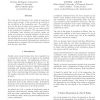Free Online Productivity Tools
i2Speak
i2Symbol
i2OCR
iTex2Img
iWeb2Print
iWeb2Shot
i2Type
iPdf2Split
iPdf2Merge
i2Bopomofo
i2Arabic
i2Style
i2Image
i2PDF
iLatex2Rtf
Sci2ools
88
Voted
ICRA
2002
IEEE
2002
IEEE
Is 3D Useful in Stereo Visual Control?
The main goal of this paper is the study of image-based stereo visual servoing. A pair of cameras is mounted on the end-effector of the manipulator arm. The visual features are the pair of images of an unknown object. The developed control laws use either the raw image points, or the estimated 3D coordinates. The experimental setup is challenging: large rotations are involved, images are noisy, and cameras are coarsely calibrated. In this setup, the trajectory of the end-effector differs notably, sometimes leading the arm near its joint range limits. Experimental results demonstrate that using pixel coordinates is disadvantageous, compared with 3D coordinates estimated from the same pixel data.
Related Content
| Added | 15 Jul 2010 |
| Updated | 15 Jul 2010 |
| Type | Conference |
| Year | 2002 |
| Where | ICRA |
| Authors | Enrique Cervera, François Berry, Philippe Martinet |
Comments (0)

